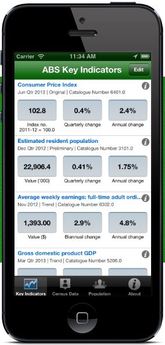
The App is extremely useful for assessing demographics in relation to property buying for owner-occupiers and investors alike. It essentially provides a snap shot of an area and compares it to other areas you may be more familiar with, allowing the user to assess how the demographics compare and how that changes the infrastructure and services available.
The ABS Mobile App offers four categories of data & information:
Key Indicators:
With access to 33 key economic indicators including CPI, GDP and unemployment updated constantly as new data becomes available, this category will assist with making better purchasing decisions.
Census Data:
Providing the most up-to-date data about people, families and dwellings in postal zones and Commonwealth electoral divisions helping to detail specific information about any area you may be considering purchasing in.
Population:
This option allows you to view population growth in a specific area with real time updates and calculates projections in forward time.
The ABS Stats mobile app is available for download from the iTunes store for free.



 RSS Feed
RSS Feed
